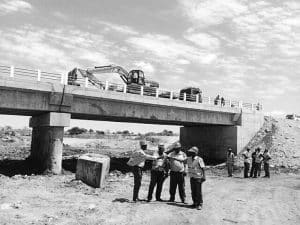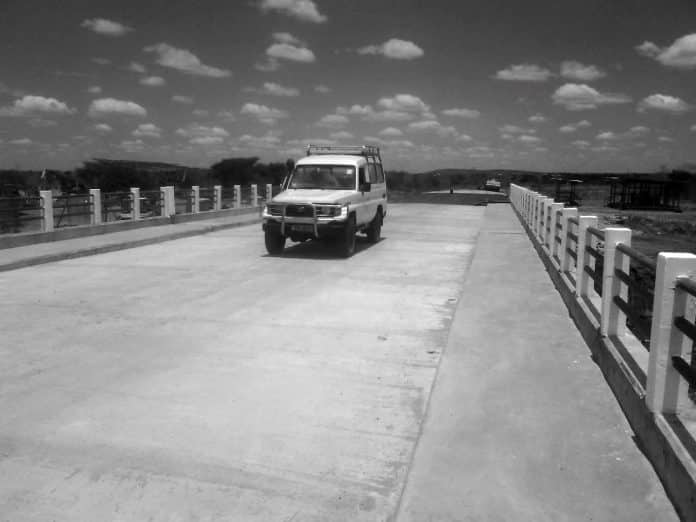Introduction to the Mbutu Bridge
The Mbutu Bridge is a remarkable engineering marvel that spans the Sibiti River in the heart of central Tanzania. This iconic structure serves as a crucial link, connecting communities, facilitating trade, and enabling the flow of essential resources across the region. Nestled amidst the lush landscapes and rolling hills of the Tanzanian countryside, the Mbutu Bridge has become a symbol of progress and resilience, standing as a testament to the ingenuity and determination of the Tanzanian people.
Importance of the Mbutu Bridge

The Mbutu Bridge plays a vital role in the lives of the local communities, as well as the broader economic and social fabric of central Tanzania. Prior to its construction, the Sibiti River presented a formidable obstacle, often forcing residents to undertake lengthy detours or risk perilous crossings. The bridge has transformed this landscape, providing a safe and efficient passage for both pedestrians and vehicles, allowing for the seamless movement of people, goods, and services.
History of the Mbutu Bridge construction
The Mbutu Bridge is the result of a collaborative effort between the Tanzanian government, international development agencies, and local stakeholders. The project was initiated in the early 2000s, with the aim of improving connectivity and fostering economic growth in the region. After years of meticulous planning, design, and construction, the Mbutu Bridge was officially inaugurated in 2010, marking a significant milestone in the country’s infrastructure development.
Features and design of the Mbutu Bridge
The Mbutu Bridge is a marvel of modern engineering, boasting a sleek and elegant design that seamlessly blends with the surrounding environment. Spanning a total length of 420 meters, the bridge features a reinforced concrete deck supported by a series of sturdy concrete piers. The bridge’s width accommodates both vehicle and pedestrian traffic, ensuring the safe passage of a diverse range of users.
One of the most striking features of the Mbutu Bridge is its striking arch design, which not only adds to its visual appeal but also enhances the structure’s overall stability and load-bearing capacity. The bridge’s lighting system, which illuminates the structure at night, further enhances its aesthetic appeal and improves safety for nighttime travelers.
Impact of the Mbutu Bridge on the local community
The Mbutu Bridge has had a profound impact on the lives of the local community, transforming the way they live, work, and interact. Prior to the bridge’s construction, residents faced significant challenges in accessing essential services, markets, and educational facilities. The bridge has now enabled faster and more reliable transportation, allowing for the efficient movement of people, goods, and resources.
This improved connectivity has had a ripple effect on the local economy, stimulating the growth of small businesses, facilitating the transportation of agricultural products, and opening up new employment opportunities. The bridge has also enhanced access to healthcare services, enabling residents to reach medical facilities more easily and receive timely treatment.
Challenges faced during the construction of the Mbutu Bridge
The construction of the Mbutu Bridge was not without its challenges. The remote and rugged terrain of the region presented logistical hurdles, requiring the coordination of complex transportation networks to deliver construction materials and equipment. Additionally, the Sibiti River’s seasonal fluctuations in water levels and the risk of flooding posed significant engineering challenges that had to be overcome.
Despite these obstacles, the project team, comprising local and international experts, worked tirelessly to ensure the successful completion of the Mbutu Bridge. Their dedication and innovative problem-solving skills were crucial in overcoming the various challenges and delivering this vital infrastructure project.
Maintenance and upkeep of the Mbutu Bridge
Ensuring the long-term sustainability and functionality of the Mbutu Bridge is a top priority for the Tanzanian government and the local authorities. A comprehensive maintenance and monitoring program has been implemented, involving regular inspections, routine repairs, and proactive measures to address any potential issues.
The bridge’s structural integrity is closely monitored, with engineers conducting regular assessments to identify and address any signs of wear and tear. Additionally, the bridge’s lighting system, signage, and safety features are meticulously maintained to ensure the safety and convenience of all users.
Future developments and expansion plans for the Mbutu Bridge

As the Mbutu Bridge continues to serve as a vital link in the region’s transportation network, there are ongoing plans to further enhance its capabilities and meet the evolving needs of the local community. Proposals include the expansion of the bridge’s capacity to accommodate increased traffic volumes, the integration of sustainable energy solutions, and the incorporation of advanced traffic management systems.
These future developments will not only improve the bridge’s efficiency and environmental impact but also contribute to the overall economic and social development of the region. By investing in the continuous improvement of the Mbutu Bridge, the Tanzanian government and local authorities are demonstrating their commitment to ensuring the long-term prosperity and well-being of the communities it serves.
Comparison with other bridges in the region
While the Mbutu Bridge stands as a remarkable engineering achievement, it is not the only significant bridge structure in the region. Across central Tanzania, there are several other notable bridges that play a crucial role in the country’s transportation network.
One such example is the Kilombero Bridge, which spans the Kilombero River and serves as a vital link between the southern and central regions of Tanzania. Like the Mbutu Bridge, the Kilombero Bridge has transformed the landscape, facilitating the movement of people, goods, and resources, and contributing to the region’s economic and social development.
Another notable bridge in the area is the Ruaha Bridge, which crosses the Ruaha River and provides a crucial connection between the eastern and western parts of central Tanzania. This bridge, with its distinct architectural design and strategic location, has become an integral part of the region’s transportation infrastructure, supporting the flow of trade and commerce.
While each of these bridges has its own unique features and challenges, they all share a common purpose: to enhance connectivity, foster economic growth, and improve the quality of life for the communities they serve.
Conclusion: The significance of the Mbutu Bridge for connectivity and development in Central Tanzania
The Mbutu Bridge stands as a testament to the power of infrastructure development to transform lives and communities. This remarkable structure has not only bridged the physical divide of the Sibiti River but has also helped to bridge the gaps in accessibility, economic opportunity, and social cohesion that once existed in central Tanzania.
As you have seen, the Mbutu Bridge has had a profound impact on the local community, improving transportation, facilitating trade, and enhancing access to essential services. This bridge has become a symbol of progress and resilience, a shining example of what can be achieved when communities, governments, and development partners work together towards a common goal.
For more information on infrastructure click here!

































